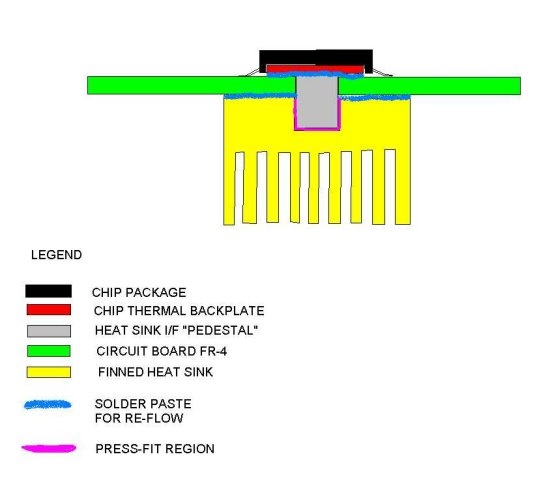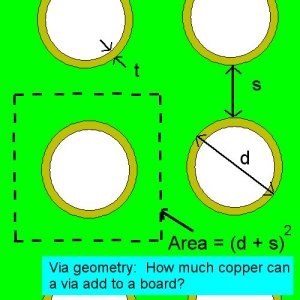|
answers to those doggone thermal design questions
by tony kordyban
dear doggone thermal guy,
i have an rf amplifier device which operates fairly inefficiently. only about 1/3 of the power it takes in goes out as rf. the rest is dissipated as heat (5 watts). the figure below shows an arrangement recommended by the rf amplifier vendor to insure that the chip is well-connected to the heat sink. the heat sink is mounted on the side of the board opposite the device. to get an adequate thermal path, the vendor recommends a "pedestal" or pin, which is press fit into the sink, and soldered to the backside of the device (the device has a metal backside plate for this purpose).
some of our circuit designers have tried this approach, but using a "solder plug" instead of a pin/pedestal. this seems to work, but our manufacturing group says it is hard to manufacture. i can see why, since it must take a bit of work to fill a 1/8 inch diameter hole full of solder. other designers say that simply stitching the front and back planes of the circuit with a dense pack of vias will be enough.
do you have any recommendations? we want to make sure that the heat sink is well-connected, but also that the board design is manufacturable.
murky in albuquerque

dear murky,
i am shocked that you think your rf device is relatively inefficient. at least 1/3 of its input power isn't completely wasted, as it is in almost any other electronic component. how much useful energy comes out of a typical microprocessor? dribs and drabs of a few milliamps once in a while on the signal leads. it is so small that i usually assume that exactly 100% of the electrical power of any component is converted to heat. but i digress.
it is easy to see why your manufacturing folks hate this heat sink arrangement. did the vendor who recommended it ever try to build such a thing on a production line? no doubt the thermal performance is great. there is metal-to-metal contact all the way from the heat spreader on the rf device to the large heat sink.
but they must be twisting their safety glasses into pretzels trying to solder the heat sink to the backside of the printed circuit board. my opinion is that it will be very difficult to get that solder paste to re-flow underneath a large heat sink. the thermal mass of the aluminum extrusion will prevent the solder from melting in the re-flow oven for a long time, probably much longer than all the rest of the components on the board can stand. either you cook the rest of the board, or you get a bad solder joint under the heat sink.
i am also afraid that the same problem (the high thermal capacitance of the heat sink) will prevent a good solder joint from forming between the pin and the heat spreader plate on the bottom of the rf device. the heat sink will "suck away" the energy needed to re-flow the solder unless you use a very long soldering time. and a long soldering time could damage the die inside your rf device.
those complainers in manufacturing probably have a similar problem with that "solder plug" idea. thermally it is nearly as good (although solder is not as good a conductor as aluminum.) with the heat sink in contact with the solder, it will be difficult to make it melt and flow where you want it to go.
the "whole bunch of vias" idea sounds like the most manufacturable approach to me. let's see if we can estimate its thermal resistance, compared to the pin and solder plug methods.
let's say we will solder the rf device to a copper pad on the top side of the board, packing as many vias as possible under that pad to connect it to the back side of the board. (a via is a small hole in a circuit board, whose sides are plated with copper. the normal purpose of a via is to make an electrical connection between the copper layers in a multi-layer circuit board. just by accident, it can also be a conductive path for heat.)
then i would attach the heat sink to the bottom of the board with adhesive, not solder paste. you might be able to use thermally-conductive, double-sided tape, if the two surfaces are flat enough. the heat sink can be attached after the re-flow process, so it will not interfere with the solder joint formation under your rf device.
let's see if we can estimate how much copper we add to a printed circuit board when we add vias. what we need to do is estimate the percent of cross-sectional area under the component that is copper, and how much is epoxy (or air or other material). that is highly dependent on the geometry of the vias. scope out this sketch.

you can't drill holes in a board right next to each other. there is a minimum distance they must be spaced, that depends on the hole diameter and the thickness of the board.let's call the edge-to-edge spacing of the holes "s".
then there is the diameter of the hole itself, "d", and the thickness of the copper plating inside the hole, "t".
the area of the board taken up by one via is given by:
area = (d + s)2
the cross-sectional area of the copper barrel in the hole is given by:
area cu = "pi" d t
so the percent of copper due to adding the via is
percent cu = "pi" d t / (d + s)2
and from that you can figure out the effective thermal conductivity of the board in the region filled with vias. you multiply the conductivity of copper (about 380 w/mc) by the percent cu. you can neglect the tiny amount contributed by the epoxy. for example, if we throw in some numbers for diameter and spacing and thickness and come out with 10% copper, we can say the conductivity of the board in that region is 38 w/mc. we'll need this little calculation in a minute.
now i'll give you the super-simplistic equation for calculating the thermal resistance of a heat conduction path. let's assume everything is one-dimensional. (for two or more dimensions, i have to start charging money.)
|
r = l/(ka)
where:
|
r is thermal resistance
|
| |
l is the length of the path
|
| |
k is the thermal conductivity of the material
|
| |
a is the cross-sectional area of the path
|
we can use this to estimate the thermal resistance of the three proposed thermal paths from the rf device to the heat sink. we know, or can make a good guess about most of the variables in this equation. the cross-sectional area of the path is known because you told me the hole for the solder plug is 1/8 inch diameter. one guess i need to make is the thickness of the board (which is l, the length of the path from the component to the heat sink). i will assume a typical board thickness of 1/16 inch.
then we have to make some initial design decisions. how big should the vias be? they can vary in size from 0.010 to 0.100 inches, depending on their purpose and manufacturing standards. i will pick for starters a diameter of 0.012 inch (0.3 mm). and with no real justification, i will assume that the i can pack them so close together that the spacing from edge of one via to the next is the same as the diameter -- 0.012 inch. i believe the plating is about 0.0007 inch thick for 1/2 ounce copper. those dimensions give me a percent cu of 4.6%, and an effective conductivity for the board of 17 w/mc.
another number i need is the thermal resistance of the adhesive layer. without getting too sticky about it, let's just say it's 1 c/w for now. that's in the realistic range. you can always put in a better number when you select your favorite adhesive.
let's see how the performance of the three paths compares:
|
thermal path
|
k (w/mc)
|
resistance (c/w)
|
temperature rise at 5w
|
|
aluminum pin
|
180
|
1.12
|
5.60 deg c
|
|
solder plug
|
50
|
4.02
|
20.1 deg c
|
|
vias and adhesive
|
17
|
11.8 (vias) + 1 (adhesive) = 12.8
|
64.0 deg c
|
the vias and adhesive are the worst thermal path. but how bad is that path? if all 5 w from your rf device go through this path, the temperature rise due to its resistance will be about 64 degrees c. whether that is bad or not depends on how close you are to the temperature limit of the rf device when it is operating in its worst case environment. maybe you have 64 degrees to spare (unlikely). if so, it might be worth spending them to get a manufacturable design.
but i have not optimized the via dimensions at all. you could increase the area under the chip filled with vias, for example. i bet if you play around with the dimensions, sticking to your manufacturing standards for vias, of course, you could find a combination that works better. (it also makes sense to use the real thickness of your board, since you know it.)
a circuit board vendor gave me a design tip that you might want to consider, too. he suggested filling the vias with solder. he claimed that a 0.012 inch via would wick up solder paste during the re-flow process and be completely filled with solder if you put paste on both sides of the board. filling the hole with solder would increase the via conductivity in my example to 27 w/mc. that would reduce the resistance to 8.4 c/w, and the temperature rise would only be 37 deg c.
talk to your circuit board vendor. talk to an adhesives vendor. (there should be some on coolingzone, if you don't have one!) don't be afraid to question their claims. because now you have a way to think about the problem that will help you find your own optimal solution.
dear lord of the pants-of-smartness,
i love your articles, and i am finding lots of good stuff on electronics cooling here on coolingzone, but it is all in dribs and drabs, to coin a phrase. a beginner like me struggles to put it all together. is there a basic textbook on this subject that can walk me through the thermal design and analysis process from beginning to end? some of the books you have recommended in the past are out of print.
mike in mechanicsville
dear mike,
out of print? you never heard of a library?
seriously, there are some good books on electronics cooling that you can't buy through amazon.com, because they are out of print, or just seem that way. but university libraries all over the globe are bulging with these tomes, and the librarians are begging people to check them out to get the dust off of them once in a while. check your local university library. if you are not a registered student, they may not lend them to you directly. sometimes you can get them on inter-library loan through your local public library.
if you just have to have your own copy of an out-of-print classic, you can often find them through one of the out-of-print booksellers on the internet. my wife suggests http://www.half.ebay.com and http://www.powells.com, which have found some obscure items (such as "the best of women's science fiction") for her.
so which ones should you look for? here's a list of books i have actually read and/or used:
in print
dave s. steinberg, cooling techniques for electronic equipment (2nd edition), john wiley & sons
out of print
gordon ellison, thermal computations for electronic equipment, van nostrand reinhold or krieger
allan d. kraus and avram bar-cohen, thermal analysis and control of electronic equipment, mcgraw hill
allan w. scott, cooling of electronic equipment, john wiley & sons
here are a couple of more in print books that i found on amazon.com. i have not read them, but they look promising from their tables of contents. i offer them for your investigation.
al krum, thermal management handbook: for electronic assemblies
air cooling technology for electronic equipment by sung-jin kim (editor), sang woo lee (editor)
that should be enough to get you started.
p.s. - i almost forgot another book by an obscure author. it's not exactly what you asked for. it's more of a book of what not to do in cooling electronics: hot air rises and heat sinks. according to the publisher, they have to clear out a lot more boxes of it before it can be called out of print.
hi, t.k.,
it's mike again. while you were surfing the net looking for cooling books, did you happen to notice any fascinating books about how to drive your car more safely? my teenage son is getting his license soon, and i wish there was a book written by a curmudgeon with literally a million driving miles under his belt who could share some of that experience, in an honest and engaging tone that my son would actually want to read.
m in m
dear m.,
funny you should mention! there's a book called how to drive into accidents - and how not to by robert a. pease, which sounds right up your alley. (yes, it's that same robert pease - analog circuits guy.) i never thought i needed to know how a differential works to drive a car, but after reading this, i can't imagine driving any other way.

about tony kordyban
tony kordyban has been an engineer in the field of electronics cooling for different telecom and power supply companies (who can keep track when they change names so frequently?) for the last 20 years. maybe that doesn't make him an expert in heat transfer theory, but it has certainly gained him a lot of experience in the ways not to cool electronics.
he does have some book-learnin', with a b.s. in mechanical engineering from the university of detroit and a master’s in mechanical engineering from stanford. in those 20 years tony has come to the conclusion that a lot of the common practices of electronics cooling are full of baloney. he has run into so much nonsense in the field that he has found it easier to just assume "everything you know is wrong" (from the comedy album by firesign theatre), and to question everything against the basic principles of heat transfer theory.
tony has been collecting case studies of the wrong way to cool electronics, using them to educate the cooling masses, applying humor as the sugar to help the medicine go down. these have been published recently by the asme press in a book called, "hot air rises and heat sinks: everything you know about cooling electronics is wrong." it is available at https://www.amazon.com/hot-air-rises-heat-sinks/dp/0791800741. this advice column is an extension of that educational effort.
|